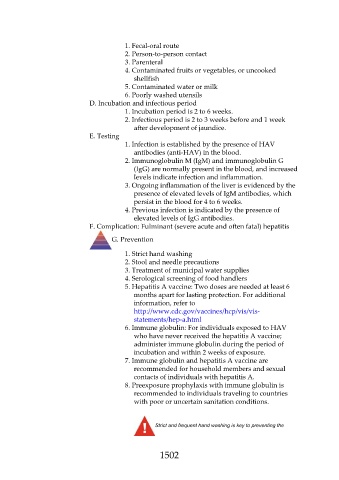Page 1502 - Saunders Comprehensive Review For NCLEX-RN
P. 1502
1. Fecal-oral route
2. Person-to-person contact
3. Parenteral
4. Contaminated fruits or vegetables, or uncooked
shellfish
5. Contaminated water or milk
6. Poorly washed utensils
D. Incubation and infectious period
1. Incubation period is 2 to 6 weeks.
2. Infectious period is 2 to 3 weeks before and 1 week
after development of jaundice.
E. Testing
1. Infection is established by the presence of HAV
antibodies (anti-HAV) in the blood.
2. Immunoglobulin M (IgM) and immunoglobulin G
(IgG) are normally present in the blood, and increased
levels indicate infection and inflammation.
3. Ongoing inflammation of the liver is evidenced by the
presence of elevated levels of IgM antibodies, which
persist in the blood for 4 to 6 weeks.
4. Previous infection is indicated by the presence of
elevated levels of IgG antibodies.
F. Complication: Fulminant (severe acute and often fatal) hepatitis
G. Prevention
1. Strict hand washing
2. Stool and needle precautions
3. Treatment of municipal water supplies
4. Serological screening of food handlers
5. Hepatitis A vaccine: Two doses are needed at least 6
months apart for lasting protection. For additional
information, refer to
http://www.cdc.gov/vaccines/hcp/vis/vis-
statements/hep-a.html
6. Immune globulin: For individuals exposed to HAV
who have never received the hepatitis A vaccine;
administer immune globulin during the period of
incubation and within 2 weeks of exposure.
7. Immune globulin and hepatitis A vaccine are
recommended for household members and sexual
contacts of individuals with hepatitis A.
8. Preexposure prophylaxis with immune globulin is
recommended to individuals traveling to countries
with poor or uncertain sanitation conditions.
Strict and frequent hand washing is key to preventing the
1502

